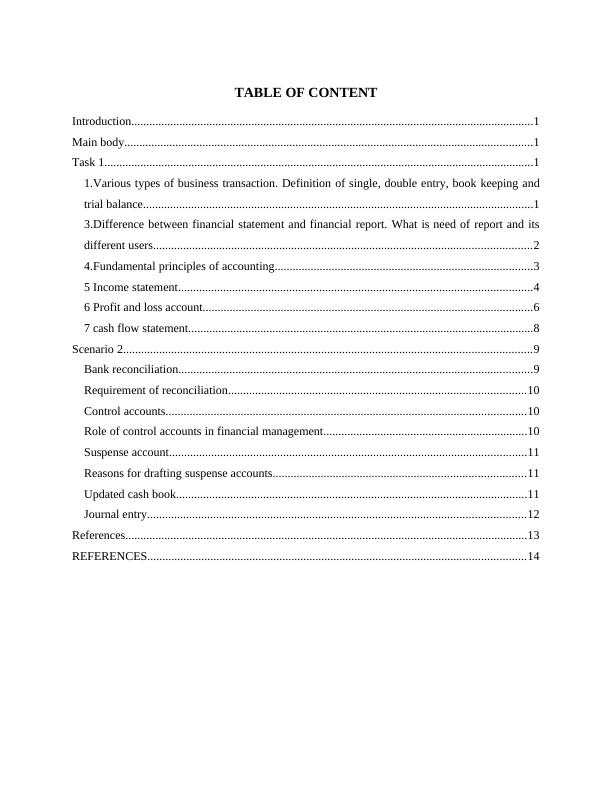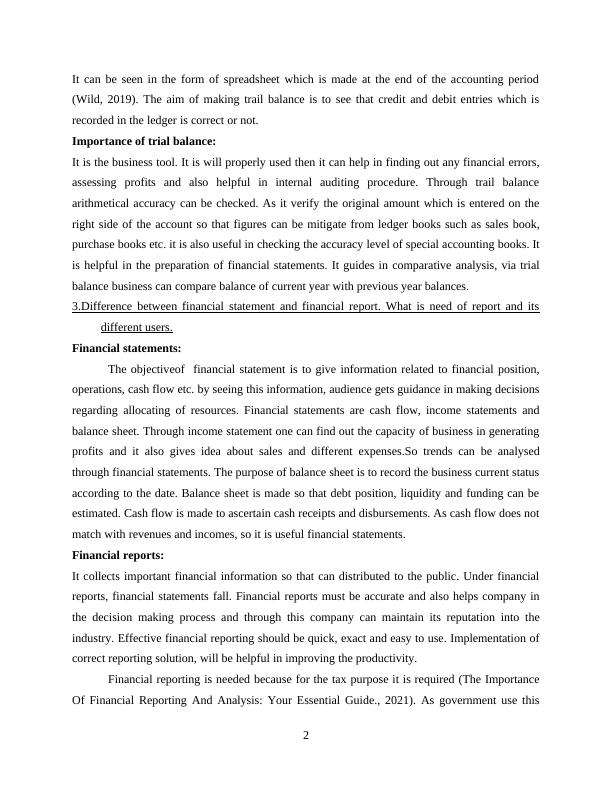Financial Accounting: Types of Transactions, Principles, Statements
Added on 2022-11-29
17 Pages4168 Words441 Views
HNBS 310 Financial
Accounting
Accounting

TABLE OF CONTENT
Introduction......................................................................................................................................1
Main body........................................................................................................................................1
Task 1...............................................................................................................................................1
1.Various types of business transaction. Definition of single, double entry, book keeping and
trial balance..................................................................................................................................1
3.Difference between financial statement and financial report. What is need of report and its
different users..............................................................................................................................2
4.Fundamental principles of accounting......................................................................................3
5 Income statement......................................................................................................................4
6 Profit and loss account..............................................................................................................6
7 cash flow statement...................................................................................................................8
Scenario 2........................................................................................................................................9
Bank reconciliation......................................................................................................................9
Requirement of reconciliation...................................................................................................10
Control accounts........................................................................................................................10
Role of control accounts in financial management....................................................................10
Suspense account.......................................................................................................................11
Reasons for drafting suspense accounts....................................................................................11
Updated cash book.....................................................................................................................11
Journal entry..............................................................................................................................12
References......................................................................................................................................13
REFERENCES..............................................................................................................................14
Introduction......................................................................................................................................1
Main body........................................................................................................................................1
Task 1...............................................................................................................................................1
1.Various types of business transaction. Definition of single, double entry, book keeping and
trial balance..................................................................................................................................1
3.Difference between financial statement and financial report. What is need of report and its
different users..............................................................................................................................2
4.Fundamental principles of accounting......................................................................................3
5 Income statement......................................................................................................................4
6 Profit and loss account..............................................................................................................6
7 cash flow statement...................................................................................................................8
Scenario 2........................................................................................................................................9
Bank reconciliation......................................................................................................................9
Requirement of reconciliation...................................................................................................10
Control accounts........................................................................................................................10
Role of control accounts in financial management....................................................................10
Suspense account.......................................................................................................................11
Reasons for drafting suspense accounts....................................................................................11
Updated cash book.....................................................................................................................11
Journal entry..............................................................................................................................12
References......................................................................................................................................13
REFERENCES..............................................................................................................................14

Introduction
The following report focuses on financial accounting. Financial accounting speaks about the
procedure of recording summarising and reporting the transactions of various business
operations for a time frame (Hoggett and et.al 2018). These transactions are being summarised
and analysed in the form of financial statements such as balance sheet income statement profit
and loss account and cash flow statement which provides information of operating performance
to the company. This report provides detailed information about various types of business
transactions including single entry and double entry bookkeeping. Along with this difference
between financial statement and financial report is being discussed in this report. Various
principles of financial accounting is also being discussed in this report. This report provides
information about bank reconciliation along with control account and suspense account.
Main body
Task 1
1.Various types of business transaction. Definition of single, double entry, book keeping and trial
balance.
Each and every organisation have business transaction either it is small or large. Some of
the transactions are as follows:
Purchasing goods- purchase can be done in the form of cash or credit. Cash purchases can be
seen rarely in business as business do not purchase everything in cash. Credit purchases are not
paid immediately.
purchasing services: services which includes advertising, equipment repairing, printing costs etc.
sales, raising finance, wages and salaries paid etc. are some transactions.
Single entry bookkeeping:
It is the simple and normal method pf the bookkeeping under this each and every transaction is
recorded in the journal as single entry (Kimmel, Weygandt and Kieso, 2018). This bookkeeping
method is the cash-based method which records incoming and outgoing cash.
Double entry bookkeeping:
It is the technique to record the transactions for each business transactions whether the
transaction is small or big. In the two accounts entry is recorded which is debit and credit. In this
system amount which is placed on the debit side should be equal with credit side.
Trial balance:
1
The following report focuses on financial accounting. Financial accounting speaks about the
procedure of recording summarising and reporting the transactions of various business
operations for a time frame (Hoggett and et.al 2018). These transactions are being summarised
and analysed in the form of financial statements such as balance sheet income statement profit
and loss account and cash flow statement which provides information of operating performance
to the company. This report provides detailed information about various types of business
transactions including single entry and double entry bookkeeping. Along with this difference
between financial statement and financial report is being discussed in this report. Various
principles of financial accounting is also being discussed in this report. This report provides
information about bank reconciliation along with control account and suspense account.
Main body
Task 1
1.Various types of business transaction. Definition of single, double entry, book keeping and trial
balance.
Each and every organisation have business transaction either it is small or large. Some of
the transactions are as follows:
Purchasing goods- purchase can be done in the form of cash or credit. Cash purchases can be
seen rarely in business as business do not purchase everything in cash. Credit purchases are not
paid immediately.
purchasing services: services which includes advertising, equipment repairing, printing costs etc.
sales, raising finance, wages and salaries paid etc. are some transactions.
Single entry bookkeeping:
It is the simple and normal method pf the bookkeeping under this each and every transaction is
recorded in the journal as single entry (Kimmel, Weygandt and Kieso, 2018). This bookkeeping
method is the cash-based method which records incoming and outgoing cash.
Double entry bookkeeping:
It is the technique to record the transactions for each business transactions whether the
transaction is small or big. In the two accounts entry is recorded which is debit and credit. In this
system amount which is placed on the debit side should be equal with credit side.
Trial balance:
1

It can be seen in the form of spreadsheet which is made at the end of the accounting period
(Wild, 2019). The aim of making trail balance is to see that credit and debit entries which is
recorded in the ledger is correct or not.
Importance of trial balance:
It is the business tool. It is will properly used then it can help in finding out any financial errors,
assessing profits and also helpful in internal auditing procedure. Through trail balance
arithmetical accuracy can be checked. As it verify the original amount which is entered on the
right side of the account so that figures can be mitigate from ledger books such as sales book,
purchase books etc. it is also useful in checking the accuracy level of special accounting books. It
is helpful in the preparation of financial statements. It guides in comparative analysis, via trial
balance business can compare balance of current year with previous year balances.
3.Difference between financial statement and financial report. What is need of report and its
different users.
Financial statements:
The objectiveof financial statement is to give information related to financial position,
operations, cash flow etc. by seeing this information, audience gets guidance in making decisions
regarding allocating of resources. Financial statements are cash flow, income statements and
balance sheet. Through income statement one can find out the capacity of business in generating
profits and it also gives idea about sales and different expenses.So trends can be analysed
through financial statements. The purpose of balance sheet is to record the business current status
according to the date. Balance sheet is made so that debt position, liquidity and funding can be
estimated. Cash flow is made to ascertain cash receipts and disbursements. As cash flow does not
match with revenues and incomes, so it is useful financial statements.
Financial reports:
It collects important financial information so that can distributed to the public. Under financial
reports, financial statements fall. Financial reports must be accurate and also helps company in
the decision making process and through this company can maintain its reputation into the
industry. Effective financial reporting should be quick, exact and easy to use. Implementation of
correct reporting solution, will be helpful in improving the productivity.
Financial reporting is needed because for the tax purpose it is required (The Importance
Of Financial Reporting And Analysis: Your Essential Guide., 2021). As government use this
2
(Wild, 2019). The aim of making trail balance is to see that credit and debit entries which is
recorded in the ledger is correct or not.
Importance of trial balance:
It is the business tool. It is will properly used then it can help in finding out any financial errors,
assessing profits and also helpful in internal auditing procedure. Through trail balance
arithmetical accuracy can be checked. As it verify the original amount which is entered on the
right side of the account so that figures can be mitigate from ledger books such as sales book,
purchase books etc. it is also useful in checking the accuracy level of special accounting books. It
is helpful in the preparation of financial statements. It guides in comparative analysis, via trial
balance business can compare balance of current year with previous year balances.
3.Difference between financial statement and financial report. What is need of report and its
different users.
Financial statements:
The objectiveof financial statement is to give information related to financial position,
operations, cash flow etc. by seeing this information, audience gets guidance in making decisions
regarding allocating of resources. Financial statements are cash flow, income statements and
balance sheet. Through income statement one can find out the capacity of business in generating
profits and it also gives idea about sales and different expenses.So trends can be analysed
through financial statements. The purpose of balance sheet is to record the business current status
according to the date. Balance sheet is made so that debt position, liquidity and funding can be
estimated. Cash flow is made to ascertain cash receipts and disbursements. As cash flow does not
match with revenues and incomes, so it is useful financial statements.
Financial reports:
It collects important financial information so that can distributed to the public. Under financial
reports, financial statements fall. Financial reports must be accurate and also helps company in
the decision making process and through this company can maintain its reputation into the
industry. Effective financial reporting should be quick, exact and easy to use. Implementation of
correct reporting solution, will be helpful in improving the productivity.
Financial reporting is needed because for the tax purpose it is required (The Importance
Of Financial Reporting And Analysis: Your Essential Guide., 2021). As government use this
2

End of preview
Want to access all the pages? Upload your documents or become a member.
Related Documents
Financial Accounting: Types of Transactions, Trial Balance, Financial Statements, and Principleslg...
|17
|4359
|251
Financial Accounting: Types of Transactions, Double Entry Bookkeeping, Trial Balance, Financial Statements, Fundamental Principleslg...
|18
|4196
|408
Recording Financial Transactionslg...
|18
|4145
|147
Financial Accounting: Types of Transactions, Principles, and Statementslg...
|17
|3882
|169
Financial Accounting: Business Transactions, Single Entry and Double Entry System, Trial Balancelg...
|21
|4113
|31
Financial Accounting: Types of Transactions, Bookkeeping, Trial Balancelg...
|22
|4322
|2
